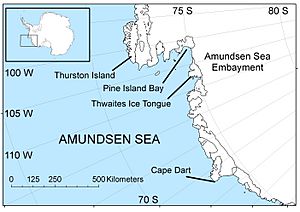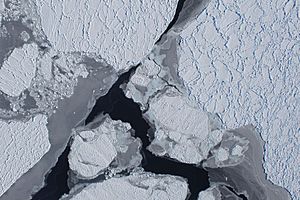Amundsen Sea facts for kids
The Amundsen Sea is an arm of the Southern Ocean off Marie Byrd Land in western Antarctica. It is bounded by Cape Flying Fish, the northwestern tip of Thurston Island to the east and Cape Dart on Siple Island to the west. East of Cape Flying Fish starts the Bellingshausen Sea. The sea is named for the Norwegian polar explorer Roald Amundsen.
The sea is mostly ice-covered. The ice sheet which drains into the Amundsen Sea averages about 3 km (1.9 mi) in thickness. It is roughly the size of the state of Texas. The area is known as the Amundsen Sea Embayment (ASE). It forms one of the three major ice drainage basins of the West Antarctic Ice Sheet.
A study in October 2004 suggested that because the ice in the Amundsen Sea had been melting rapidly and riven with cracks, the offshore ice shelf was set to collapse "within five years". The study projected a sea level rise of 1.3 m (4.3 ft) from the West Antarctic Ice Sheet if all the sea ice in the Amundsen Sea melted.
Measurements made by the British Antarctic Survey in 2005 showed that the ice discharge rate into the Amundsen Sea was about 250 km3 per year. Assuming a steady rate of discharge, this alone is sufficient to raise global sea levels by 0.2 mm per year.
A sub-glacial volcano has also been detected in the area, just north of the Pine Island Glacier near the Hudson Mountains. It last erupted approximately 2,200 years ago, indicated by widespread ash deposits within the ice, in what was the largest known eruption in Antarctica within the past 10 millennia.
Volcanic activity in the region may be contributing to the observed increase of glacial flow, although currently the most popular theory among the scientists studying this area is that the flow has increased due to warming ocean water. This water has warmed due to an up-welling of deep ocean water which is due to variations in pressure systems, which could have been affected by global warming.
Pine Island Bay
Pine Island Bay is a bay about 40 miles (64 km) long and 30 miles (48 km) wide. The ice of the Pine Island Glacier at the southeast end of the Amundsen Sea flows into it. It was named for USS Pine Island.
Russell Bay
Russell Bay is a rather open bay in southwestern Amundsen Sea. It goes along the north sides of Siple Island, Getz Ice Shelf and Carney Island, from Pranke Island to Cape Gates. It is named for Admiral James S. Russell, USN, Vice Chief of Naval Operations.
Images for kids
See also
 In Spanish: Mar de Amundsen para niños
In Spanish: Mar de Amundsen para niños






